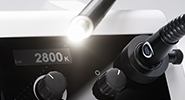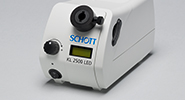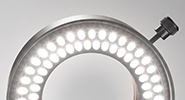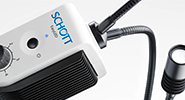ColdVision Fiber Optic Illumination
SCHOTT ColdVision Fiber Optic Illumination for machine vision and stereo microscopy brings together LED light sources, fiber optic light guides and accessories in a single, versatile service where the products are specially designed to work together.
Fibre, Microscope, Lightsource, Cold Vision, CVLS, MCLS, ACE, DCR, Gooseneck, Ring Light, Ringlight, Linelight, Line Light, Backlight, Back Light
A20980/6000K
A20980/3000k
A20980/RGBW
A20990
A08506
158.340
A08590
A08591
A08525
A08526
A08508
A08035
A08055
A08070
A08071
A08072
A08073
A08074
A08075
A08931
A08080
A08082
A08084
A08090
A08614
A08615
A08632
A08652
A08705
A08571
A08572
A08824
A08826
A08828
A08830
A08832
A08834
A08836
A08009
A08002
A08013
H09063.026
H09063.027
H09063.028
A08920
A08923
A08925
A08927
A08922
A08926
A08020.40
A08020.60
A08025.40
A08025.60
A08031.40
A08031.60
A08031.80
A08051.40
A08051.60
A21200
A08545
A08530
A08540
A08550
A08550.72
A08031.40R
A08031.60R
A08031.80R
A21040
A21045
A21050
A08400
A08410
A08500
A08575
A08520
A08520.60
A08589
A08579
A08583
A08904
A08906
A08908
A08910
A08912
A08914
A08916
A08975
A08650
A08660
A08630
A08700
A08710
A08625
A08600
A22780
A209806000K
A209803000k
A20980RGBW
158340
H09063026
H09063027
H09063028
A0802040
A0802060
A0802540
A0802560
A0803140
A0803160
A0803180
A0805140
A0805160
A0855072
A0803140R
A0803160R
A0803180R
A0852060
Fibre, Microscope, Lightsource, Cold Vision, CVLS, MCLS, ACE, DCR, Gooseneck, Ring Light, Ringlight, Linelight, Line Light, Backlight, Back Light
A20980/6000K
A20980/3000k
A20980/RGBW
A20990
A08506
158.340
A08590
A08591
A08525
A08526
A08508
A08035
A08055
A08070
A08071
A08072
A08073
A08074
A08075
A08931
A08080
A08082
A08084
A08090
A08614
A08615
A08632
A08652
A08705
A08571
A08572
A08824
A08826
A08828
A08830
A08832
A08834
A08836
A08009
A08002
A08013
H09063.026
H09063.027
H09063.028
A08920
A08923
A08925
A08927
A08922
A08926
A08020.40
A08020.60
A08025.40
A08025.60
A08031.40
A08031.60
A08031.80
A08051.40
A08051.60
A21200
A08545
A08530
A08540
A08550
A08550.72
A08031.40R
A08031.60R
A08031.80R
A21040
A21045
A21050
A08400
A08410
A08500
A08575
A08520
A08520.60
A08589
A08579
A08583
A08904
A08906
A08908
A08910
A08912
A08914
A08916
A08975
A08650
A08660
A08630
A08700
A08710
A08625
A08600
A22780
A209806000K
A209803000k
A20980RGBW
158340
H09063026
H09063027
H09063028
A0802040
A0802060
A0802540
A0802560
A0803140
A0803160
A0803180
A0805140
A0805160
A0855072
A0803140R
A0803160R
A0803180R
A0852060

















